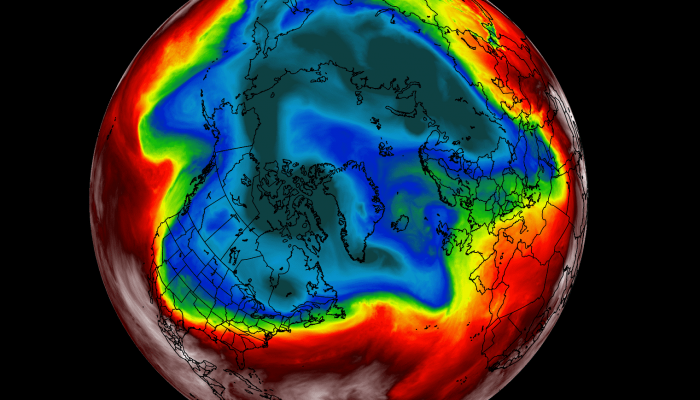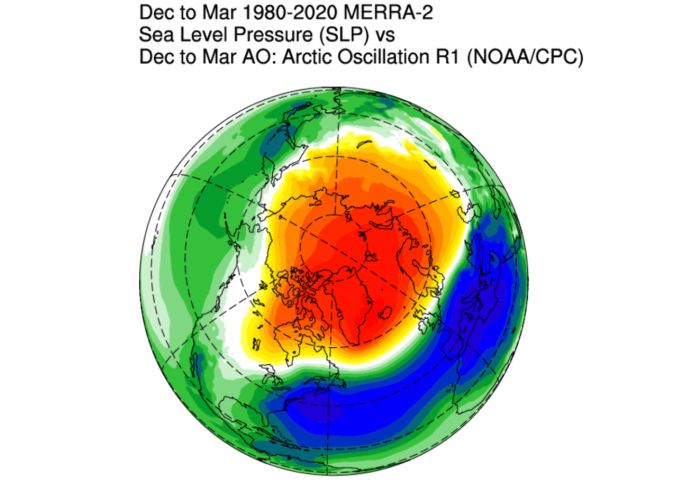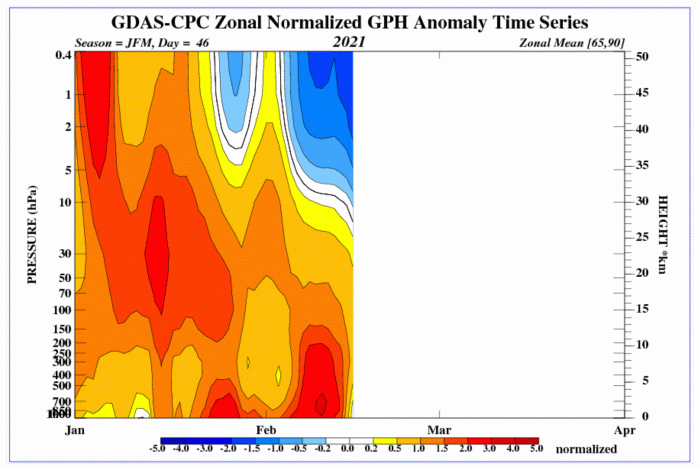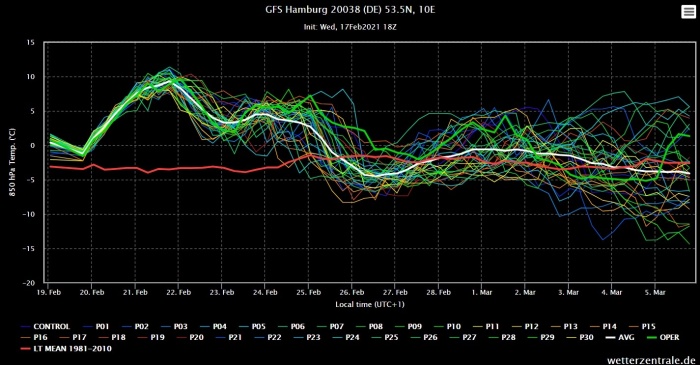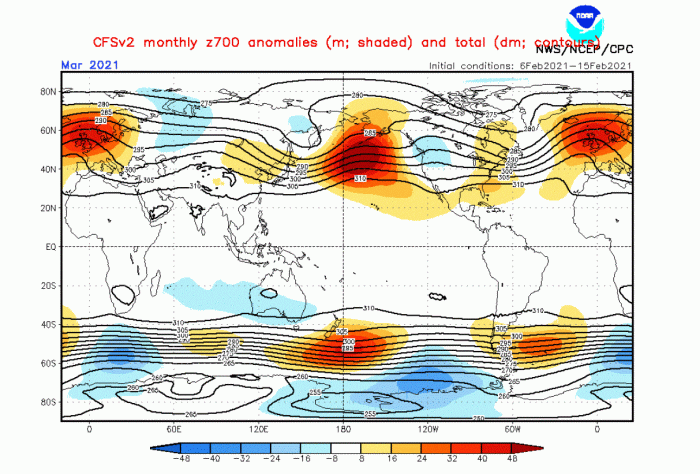Winter weather has slowly reached its peak, and we are now starting to see the first signs that Spring is starting to awaken. Polar circulation is changing, trying to strengthen, bringing us some warmer weather in the coming weeks.
But it is not so simple to change the weather seasons. It takes a lot of energy, and thankfully, the weather is full of energy. As you will see, the same power that provided cold arctic outbreaks across the United States and Europe will now aim to awaken Spring weather.
POLAR CIRCULATION AND OUR WEATHER
Every winter we hear a lot about the jet stream, Polar Vortex, and polar circulation. They are all part of the same system, having a direct influence on our weather.
The example image below features all in one, as it shows the temperature at around 4km altitude. It nicely outlines the main core of the polar vortex over the hemisphere (cold colors). The jet stream is usually found on the boundary between the warm and the cold air masses.
We produced a high-resolution video forecast of this polar circulation, where you can see in great detail how this large system works, driving the pressure systems and our weather.
To keep a better track of all these processes, a simple weather index was invented, called the Arctic Oscillation (AO). This is very similar to a stock market index on Wall Street, as it also goes (oscillates) up and down.
The Arctic Oscillation is simply derived from the pressure anomalies over the North Pole. When high-pressure rules over the polar regions, the AO goes negative. And when low-pressure dominates the Polar regions, the AO is positive, meaning a stronger polar circulation.
Below we have a very simple schematic of the Arctic Oscillation (AO). The positive AO means a strong jet stream and strong circulation. It locks the colder air into the Polar regions, with mild/warm conditions prevailing in the mid-latitudes. It opposite in the negative AO mode.
The image below shows the typical pressure anomaly during a negative polar circulation mode. We have high pressure dominating the North Pole. That unlocks the cold air out of the Arctic and down into Europe and the United States.
Looking at the temperature pattern during a negative polar circulation, you can see the displaced cold air. We have colder than normal air over central and eastern United States, northern and central Europe, and Siberia.
Below is the sea-level pressure anomaly for the winter so far. We can nicely see the exact pattern as the negative Arctic Oscillation shows above. High pressure over the North Pole and low-pressure displaced towards the lower latitudes.
The temperature pattern this winter is also similar to the negative polar circulation. Very cold Eurasia, with colder temperatures also over Europe and most of the eastern half of the United States. This is almost a 3-month average, so individual cold outbreaks get watered down in the average.
FROM WINTER TO SPRING…
This winter was perhaps a bit unusual as far as the polar circulation goes. For most of the winter season, the polar weather circulation was in the negative mode.
You can see on the image below, that there are two graphs. On the bottom, we have the polar circulation index, which is strongly negative for the entire winter period. Above it, we have the pressure anomaly in the lower 30km of the atmosphere.
What stands out, are the strong high-pressure anomalies coming down from the higher layers of the atmosphere. That was due to a strong Stratospheric Warming event and the Polar Vortex collapse. A lot was written already about this event, and we will include a link on the bottom to a more detailed analysis of these events and how they impacted our weather.
The stratospheric warming event has strongly disputed the circulation, first in the stratosphere, end then also lower down, influencing our weather in January and February.
The image below is another analysis of pressure anomalies in the lower 50km of the atmosphere. You can see the strong positive anomalies starting in early January, quickly making their way down to the surface, and impacting our weather.
But you can see on the image above, that low-pressure anomalies are starting to emerge now higher up in the atmosphere. This is a sign that the polar circulation at that level is now recovering, slowly extending its influence downwards.
Taking a look at the forecast, we can see this low-pressure area extending downward from the higher levels of the atmosphere, towards the surface, and our weather.
These higher levels are the domain of the stratospheric Polar Vortex. Seeing these low-pressure anomalies extending down can only mean that the Polar Vortex is strengthening again, trying to take control.
Below is an image of the polar vortex at around 30km altitude. You can see its shape and temperature. It is slightly displaced towards North America, but it is now in the power-up phase.
But towards the end of February and into early March, the Polar Vortex will power up, as mentioned before. You can see on the forecast below, that it will move back over the North Pole. The temperature will drop in its core, also signaling that it is gaining strength.
One way to measure the strength of the Stratospheric Polar Vortex is by looking at the wind speeds around it. Think of this like the jet stream at a higher altitude. The forecast image below by Simon Lee, shows the wind speeds increasing and holding steady deep into March 2021.
The polar circulation forecast is also reflecting on these power changes, going into the positive mode for the first time this witner.
As you will now see, these changes will directly impact our weather, starting to awaken the more Spring-like weather patterns.
LATE FEBRUARY AND EARLY MARCH WEATHER TRENDS
Currently, we still have a low-pressure area transiting over the United States, while a high-pressure system has crawled over Europe. A strong low-pressure area has returned over the North Atlantic after quite a while.
Temperature anomalies reveal the ongoing cold outbreak over the United States. Temperatures will slowly start to rise again, as the arctic airmass moves on towards the east and into the North Atlantic.
On the other side of the Atlantic, Europe will experience a warm wave, bringing higher temperatures over the continent. Temperatures will be several degrees above the long-term average, giving a more early Spring feel.
The transition from February into March will bring higher pressure for the eastern half of the United States. This is partially a response to the stronger low-pressure area over western Canada, likely powered also by its connection to the stratospheric Polar Vortex, which we mentioned before.
In the meantime, the high-pressure system will remain stable over Europe, holding a warmer airmass over the continent.
The low-pressure area over western Canada is partially strengthening due to the conditions in the North Pacific. But as we mentioned, it seems to be directly powered by the stratospheric Polar Vortex, also gaining power.
You can see on the two images below, where the position of the Polar Vortex is. The first image is at around 20km altitude, showing the core of the vortex over Northern Canada. The second image shows the pressure pattern in the lower levels, with the strong low-pressure system directly under the core of the stratospheric vortex.
Below we can see the temperature forecast for the end of February, with early Spring weather conditions over Europe. Especially strong anomalies are seen over the central and southeastern parts.
Over North America, you can see the strong cold-core over western Canada. But the southerly winds will finally bring warmer temperatures and early Spring weather conditions over the southern and the eastern United States if the pattern forecast holds.
But early March will likely see some adjustment. The high-pressure area over Europe will crawl further north, connecting with the remnant Polar high-pressure area.
The low-pressure area will move closer towards eastern Europe from Russia, transporting some colder air from the east along the way.
Over North America, a likely scenario is that the low-pressure area over western Canada will extend into the western United States. From here on, some models show a possibility of a transitional cold front over the north-central United States.
The temperature forecast below shows the cold air expanding from western Canada into the north-central United States. This cold air does seem to be more transitional with the lowest temperatures confined more in the northern half of the country.
Over Europe, the continent remains warmer than average, but the colder air is approaching from the east. Depending on the strength of the high-pressure over Europe, it could briefly spill into central Europe, but the growing spring pattern influence should limit a longer-lasting cold outbreak event.
Despite transitioning into a stronger polar circulation mode, with slow activation of Spring weather, cold fronts in transition can be a common occurrence in the first weeks of Spring.
No weather season transitions easily and directly, from today to tomorrow. So as we slowly shift the weather pattern more into Sping mode, cold fronts are still common, but they slowly reduce in frequency.
The upcoming weather pattern will be an obvious “upgrade” from the persistent cold weather and winter storms as we have seen over the United States in the past weeks. Southerly winds and warmer temperatures will return to the southern and eastern United States.
Looking at some ensemble forecast trends for the United States and Europe, we can see the current temperature increase. Temperature trends do not indicate major long-term cold periods developing, with only transitional cold fronts likely. Forecast show trends for Milwaukee and Dallas in the United States, and Hamburg in Germany in Europe.
The temperatures above are at the 850mb pressure level, which is around 1500m (5000ft) altitude. This gives un an idea of the type of air mass (colder/warmer). Temperatures at the surface are in most cases a few degrees warmer.
EXTENDED RANGE WEATHER
Deeper into March 2021, the current trends from the ECMWF show a stronger polar circulation, with lower pressure over the North Pole. High pressure remains over Europe and over the southern and eastern United States.
The temperature trend shows warmer temperatures in the southern and northeastern United States. Neutral conditions are shows over the northwestern United States, where there is a high chance of continued colder air extensions from the cold-core over western Canada.
Europe will remain mostly warmer than normal under the prevailing high-pressure system. But, the close proximity of the low-pressure system over Scandinavia does pose a threat for an occasional colder airmass descending towards eastern and central Europe.
Looking quickly over the entire month of March, the pressure forecast from CFSv2 does show strong high-pressure areas over Europe and the North Pacific. We do not see any high-pressure zones present over the North Pole, signaling the Polar Circulation will be in a more prevailing positive mode this month.
The prevailing positive mode means cold air is locked up in the Polar regions, with fewer cold outbreaks than normal. But with strong high-pressure anomalies over northwestern Europe and the North Pacific, there can be exceptions.
As the temperature forecast below shows, there is a cold air anomaly in east-central Europe. That is due to the high-pressure area over northwestern Europe, which can pump colder air from the north and east on its eastern side, as it spins clockwise.
Over the United States, the North Pacific high-pressure area usually means lower pressure over western Canada extending down into the western United States. This also means more cold air transport from the north over the western and the northwestern United States. On the other side, this means a more southerly warmer flow for the central and eastern United States.
We will keep you updated as fresh data is available, and more reliable forecasts are released for the coming weeks. So make sure to bookmark our page, and activate the “show more” button on this article if you are reading us from the Google Discover feed.
SEE ALSO:
Deep snow will impact New York again, dangerous ice storm for North Carolina and Virginia
Learn more about the Stratospheric Warming event and the importance of the Stratospheric Polar Vortex.
